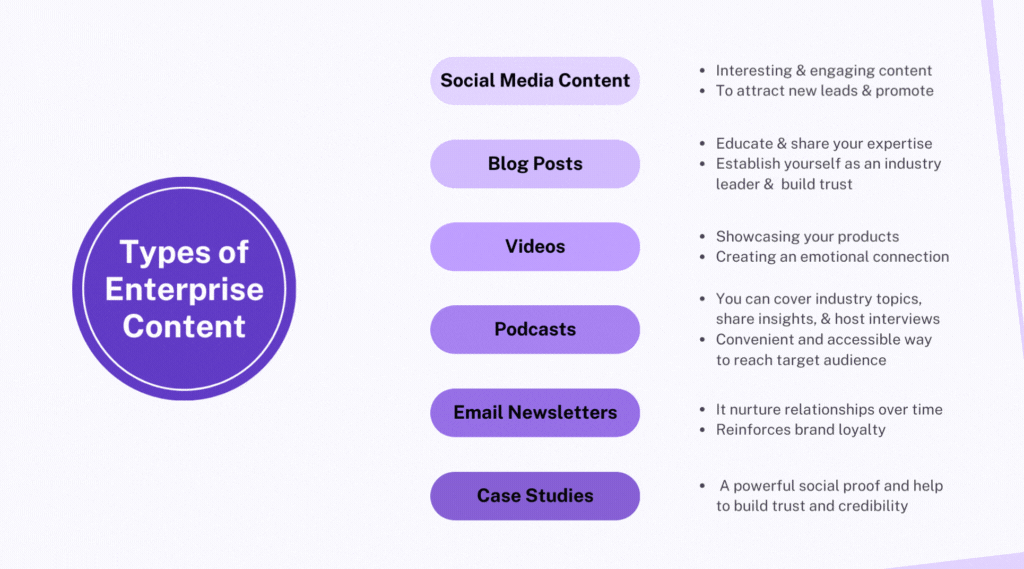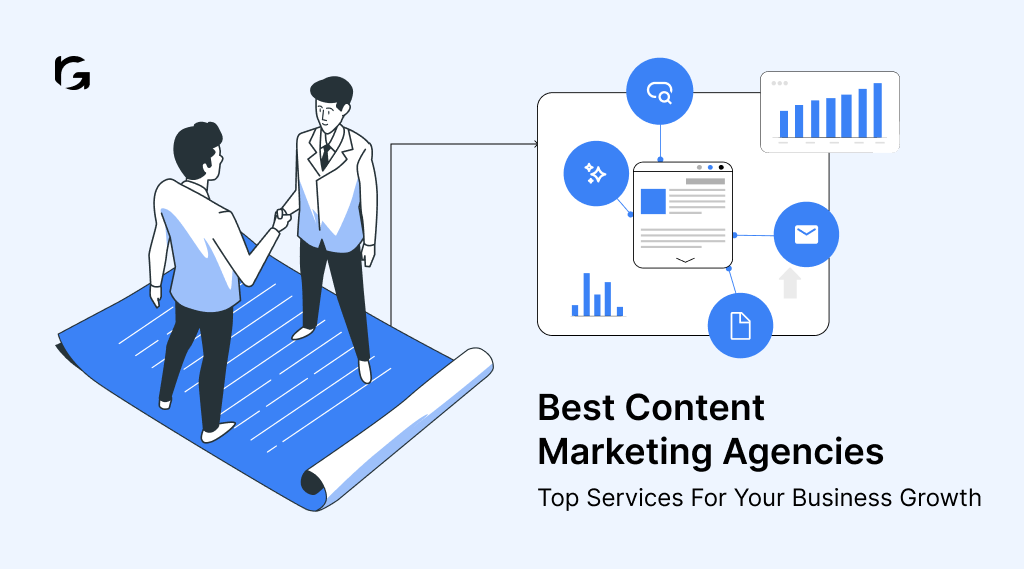Introduction
Today, large organisations are producing content at a scale that was once unimaginable yet very few feel confident about their enterprise content strategy. The challenge isn’t just creating content; it’s creating aligned, scalable, personalised, and revenue-driven content across dozens of channels, teams, markets, and customer journeys.
According to study, only 17% of marketers treat content as a standalone initiative, while 60% blend it with sales, demand gen, or brand communications. Meanwhile, 14% still have no documented strategy, a dangerous gap for any enterprise hoping to stay relevant in an AI-driven market.
The truth is simple:
Enterprise brands can’t grow without strategic content marketing.
Whether you’re promoting enterprise solutions, improving brand authority, enabling sales teams, or building a pipeline engine your content defines your brand’s narrative and competitive edge.
In this guide, you’ll learn everything you need to build a future-ready, scalable, and high-impact B2B enterprise content marketing engine.
What is enterprise content marketing?
Enterprise content marketing is a large-scale, strategic approach where big organisations create, distribute, optimise, and measure content across multiple channels to engage audiences and drive business growth.
Unlike regular content marketing, enterprise content creation involves:
- multiple teams across regions
- large budgets and automation tools
- advanced workflows
- multi-stage approval processes
- multiple customer personas
- complex buyer journeys
A simple enterprise marketing definition is:
A system where large organisations use valuable content to attract, nurture, convert, and retain customers at scale.
The goal is not just publishing more content, it's creating a strategic content marketing ecosystem that supports brand visibility, sales enablement, thought leadership, demand generation, retention, and product education.
A strong enterprise content strategy also ensures:
- consistent messaging across global markets
- unified brand voice
- seamless cross-team collaboration
- reliable analytics to measure true business impact
What are the common types of enterprise content marketing to adopt in 2026?
Enterprise content strategies vary depending on the organization's goals and target audience. Here are some of the most common types of enterprise content strategies:

- Social media content
- Blog posts
- Videos
- Podcasts
- Email newsletters
- Case studies
Let's understand the types shortly.
1. Social media content
When it comes to social media, creating content that's interesting and engaging can go a long way in attracting new leads and promoting your brand. By showcasing your brand, services, or products in a fun and creative way, you can catch the eye of your target audience and encourage them to interact with you. Social platforms give enterprises a direct line to their audience. With the right storytelling and visuals, enterprises can:
- establish brand personality
- promote new features
- highlight customer wins
- engage communities at scale
Platforms like LinkedIn, X, and Instagram are ideal for promoting enterprise products through thought leadership, employee advocacy, and expertise-driven content.
2. Blog posts
Blogging is a great way to share your expertise and educate your audience. By publishing informative and relevant articles, you can establish yourself as an industry leader and build trust with your readers. A well-crafted blog post can address common pain points and offer solutions that guide your audience through their journey. Blogs remain the backbone of b2b enterprise content marketing.
Well-researched, SEO-focused blog content helps enterprises:
- rank for high-value keywords
- answer customer pain points
- drive organic demand
- build topic authority
When executed consistently, blogs fuel demand generation, inbound sales, and long-term organic growth.
3. Videos
The use of video content can help you establish a more personal connection with your audience. By leveraging a free online video editor, you can easily create visually appealing and engaging material that effectively communicates information, builds an emotional connection, and fosters brand loyalty.
Video is the fastest-growing enterprise content format due to its visual impact. Enterprises use videos for:
- explainer demos
- customer testimonials
- feature walkthroughs
- behind-the-scenes storytelling
Short-form videos (under 60 seconds) and long-form YouTube content both play a role in engagement and trust building.
4. Podcasts
Creating audio content in the form of podcasts allows you to reach and engage with your target audience in a convenient and accessible way. Podcasting allows enterprises to reach busy professionals who prefer on-the-go learning.
Brands use podcasts to:
- share expert insights
- host interviews
- discuss trends
- build niche authority
It’s a powerful channel for thought leadership and high-intent audience building.
5. Email newsletters
Sending regular newsletters to subscribers is an effective way to stay connected with your audience and nurture relationships over time. Email newsletters keep enterprises connected to customers, prospects, and partners. They help in:
- nurturing long-term relationships
- sharing updates and launches
- segment-based communication
- delivering value directly to inboxes
A great newsletter strategy builds trust and consistently drives qualified traffic.
6. Case studies
Sharing real-life examples of how your products or services have positively impacted customers allows you to demonstrate your value proposition in a tangible and relatable manner. Case studies remain the strongest form of social proof. Enterprises leverage them to:
- highlight measurable results
- show real customer stories
- build confidence in enterprise solutions
They are essential in competitive B2B markets where buyers depend on peer validation.
How do you develop and implement an effective content marketing strategy for your business?
Creating an B2B enterprise content strategy involves developing a comprehensive plan for using content to achieve business objectives and engage the target audience effectively. Here are the steps involved:
- Define your goals
- Understand your audience
- Conduct a content audit
- Develop a content plan
- Create a content calendar
- Allocate resources
- Create and distribute content
- Measure and optimize
Let’s understand these steps involved in B2B enterprise content marketing strategy.
1. Define your goals
Start by identifying what you want to achieve with your content strategy. Begin with clarity. Identify whether your content should drive:
- brand awareness
- enterprise product adoption
- pipeline generation
- customer retention
- cross-sell opportunities
- thought leadership
Clear KPIs prevent fragmented content efforts.
2. Understand your audience
Use buyer personas, customer interviews, analytics, and intent data to understand:
- pain points
- motivations
- buying triggers
- objections
- decision-making roles
Enterprise buying cycles are long, personalisation is crucial.
3. Conduct a content audit`
Identify what you have, what’s working, and what needs improvement.
- blogs
- landing pages
- videos
- sales enablement assets
- product documentation
- email sequences
This is the foundation of strategic content marketing.
4. Develop a content plan
Based on your goals and audience insights, create a content plan that outlines the types of content you will produce, the channels you will use for distribution, and the frequency of publication. Your plan must include:
- core content pillars
- topic clusters
- content types
- distribution channels
- audience segments
- funnel stages
This ensures every content asset serves a purpose.
5. Create a content calendar
Organize your content production and publication schedule with a content calendar. A structured calendar helps teams maintain consistency across global regions.
Include:
- publishing dates
- formats
- owners
- deadlines
- promotion workflows
- cross-functional approvals
6. Allocate resources
Determine the resources required to execute your content strategy, including team roles, content creation tools, and budget for content promotion. Enterprise content creation requires:
- content strategists
- writers
- designers
- video teams
- SEO specialists
- subject matter experts
- analytics support
You may also need an B2B enterprise content marketing platform for workflow automation.
7. Create and distribute content
Start producing high-quality, relevant content that resonates with your audience. Use a mix of formats and channels for distribution to reach your audience where they are most active. Produce high-quality, useful content that aligns with your brand guidelines and audience stages.
Then distribute it through:
- social media
- newsletters
- organic search
- paid channels
- communities
- YouTube
- partnerships
Distribution is as important as creation.
8. Measure and optimize
Continuously monitor the performance of your content against your goals. Use analytics to understand what’s working and make data-driven decisions to refine and optimize your content strategy over time. Track:
- organic traffic
- search rankings
- engagement metrics
- conversions
- content ROI
- multi-touch attribution
Use insights to refine your enterprise content strategy.
What are the challenges in enterprise content marketing and how to overcome them?
Enterprise content marketing, while potentially highly effective, comes with its own set of challenges. Here are some common challenges and strategies to overcome them:
- Content scale and consistency
- Audience engagement and personalization
- Resource allocation and budget constraints
- Measuring ROI and demonstrating value
- Content distribution and amplification
- Staying ahead of trends and competition
- Maintaining brand consistency and compliance
Let us understand each of them in detail:
1. Content scale and consistency
- Enterprises often have a large volume of content to manage across various platforms, which can lead to inconsistencies in messaging and quality.
- To overcome this, establish a content calendar that outlines themes, topics, and publication schedules.
- Invest in content management systems (CMS) that facilitate collaboration and streamline the content creation process.
2. Audience engagement and personalization
- Enterprises may struggle to engage their target audience effectively, especially when dealing with diverse customer segments.
- Utilize data analytics to understand audience behavior and preferences, allowing for more personalized content.
- Implement marketing automation tools to deliver targeted content based on user interactions and demographics.
3. Resource allocation and budget constraints
- Content marketing initiatives often require significant resources, including manpower, time, and budget.
- Allocate resources efficiently by prioritizing high-impact content initiatives and leveraging existing assets.
- To optimize resource utilization, consider outsourcing specific tasks, such as content creation or analytics, to specialized agencies or freelancers.
4. Measuring ROI and demonstrating value
- Demonstrating the ROI of content marketing efforts can be challenging, particularly in enterprises with complex sales cycles and multiple touchpoints.
- Set clear objectives and key performance indicators (KPIs) aligned with business goals, such as lead generation, brand awareness, or customer retention.
- Utilize advanced analytics tools to track and measure the impact of content across the entire customer journey.
5. Content distribution and amplification
- Creating great content is only half the battle; ensuring it reaches the right audience is equally important.
- Develop a multi-channel distribution strategy that leverages owned, earned, and paid media channels to amplify reach.
- Partner with influencers, industry publications, and relevant communities to extend the reach of your content through partnerships and collaborations.
6. Staying ahead of trends and competition
- Enterprises need to stay updated with the latest trends and technologies in content marketing.
- Invest in continuous learning and professional development so your team can stay ahead of the curve.
- Monitor competitor strategies and industry trends to identify opportunities for innovation and differentiation.
7. Maintaining brand consistency and compliance
- Enterprises operating in regulated industries or with multiple brands face challenges maintaining brand consistency and compliance across all content assets.
- Develop comprehensive brand guidelines and governance processes to ensure consistency in messaging, tone, and visual identity.
- Implement compliance checks and approvals to mitigate the risk of regulatory violations or brand reputation damage.
Read More: 13 Content Marketing Mistakes to Avoid for B2B SaaS in 2025
FAQs
How can Revv Growth help you create your enterprise content strategy?
Creating a strategy for your business's content can be tough. You need to know a lot about your industry and have the right skills and experience. If you're a SaaS business, you might not have everything you need to make the best plan for your content marketing. But Revv Growth can help.
We are a saas content marketing agency, learn how to make a plan that fits your goals. So why wait? Connect with us today!



.svg)



.webp)